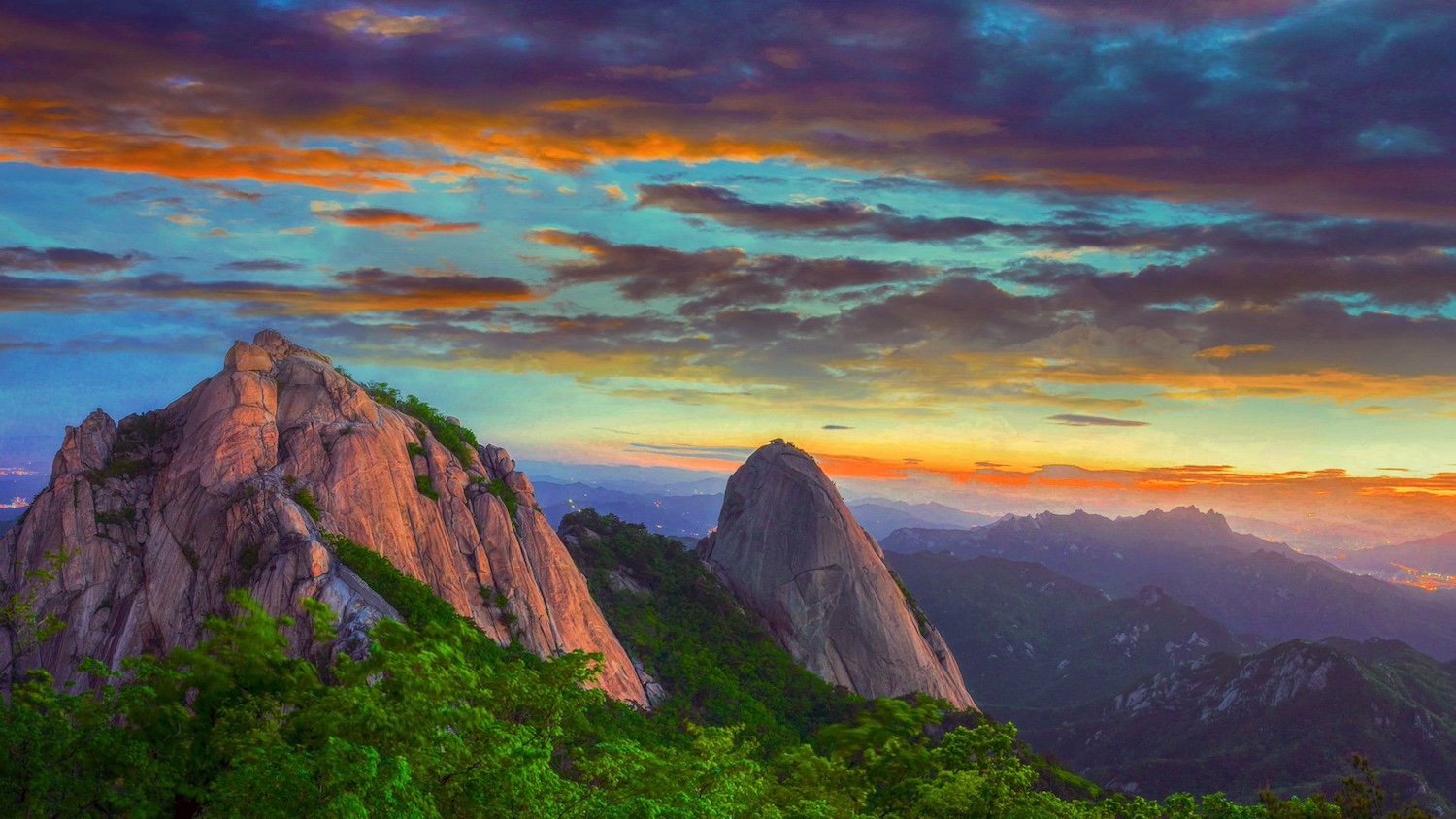
The Best of South Korea
South Korea, a vibrant and dynamic country, offers a unique blend of ancient traditions and modern innovations. Its allure lies not just in its cutting-edge technology and bustling cities, but also in its rich cultural heritage and diverse culinary scene.
From the bustling markets of Seoul to the serene temples of Jeolla, South Korea is a feast for the senses. The country’s food culture is renowned worldwide, with dishes like bibimbap and Korean BBQ captivating food enthusiasts everywhere.
In this article, we explore some of the best sights to see around South Korea: the historical palaces of Seoul, the stunning beaches of Busan, the culinary heartland of Jeolla, and the natural beauty of Seoraksan National Park.
Seoul: The Heartbeat of Korea
Seoul, the capital city, is a sprawling metropolis where modern skyscrapers meet ancient temples. It’s a city that never sleeps, offering everything from high-end shopping and gourmet dining to historic sites and vibrant nightlife. With a population of over 16 million, Seoul is a city of contrasts and surprises, making it a must-visit destination.
Where to Stay
Le Meridien, Gangnam Located in the trendy Gangnam district, Le Meridien offers 336 art-filled rooms that blend modern luxury with Korean cultural elements. This stylish hotel is ideally situated near upscale shopping, dining hotspots, and vibrant nightlife, making it perfect for both relaxation and exploration.
Four Seasons Hotel Seoul: Located in the heart of Seoul, Four Seasons Hotel offers stylish accommodations with stunning city views. The hotel features spacious rooms, an indoor pool, a spa, and multiple dining options, including a Michelin-starred restaurant, providing an opulent stay for travellers.
Where to Eat
Namdaemun Market: As South Korea’s oldest and largest market, Namdaemun is a hive of activity offering a wide variety of goods and foods. Visitors can savor local delicacies such as tteokbokki (spicy rice cakes) and stewed beltfish in a lively, traditional setting that has been bustling since the 1400s.
Dongdaemun Market: Known for its vibrant nightlife and vast array of textiles, Dongdaemun comes alive after dark. It’s a favorite spot for fashionistas and food lovers, offering dishes like mandu (dumplings) and dak hanmari (whole chicken) in the neon-lit “Let’s Eat Alley.”
Gwangjang Market: This market is famous for its traditional Korean street food. Visitors can enjoy bindaetteok (mung bean pancakes) and soondae (blood sausage) while exploring stalls filled with silk and satin bedding and hanbok (traditional Korean attire).
Byeokje Galbi: Best known for its marinated galbi, Byeokje Galbi has been a quintessential high-end Korean barbecue house since 1986. They source the highest-quality hanwoo beef from daily auctions, ensuring top-grade meat with exceptional marbling, referred to as “snow flower.” In addition to their premium beef, the restaurant also features masters of naengmyeon (cold buckwheat noodles) and gomtang (beef bone soup), each with decades of experience.
What to See
Gyeongbokgung Palace: This largest palace in Seoul, built in 1395, is a stunning example of Korean architecture and history. It features beautiful gardens and two museums, offering a glimpse into Korea’s royal past.
Bukchon Hanok Village: Nestled between Gyeongbokgung Palace and Changdeokgung Palace, this traditional village showcases hundreds of hanoks (traditional Korean houses), allowing visitors to step back in time and experience Korean culture.
Dongdaemun Design Plaza (DDP): Designed by Zaha Hadid, this futuristic building is a hub for design, fashion, and culture. It hosts exhibitions, fashion shows, and a history museum, making it a must-visit for architecture and design enthusiasts.
Namsan Seoul Tower: Offering panoramic views of Seoul, this tower is a popular spot for both tourists and locals. Visitors can enjoy the scenery from the observation deck or the rotating restaurant.
Busan: The Coastal Gem
Busan, South Korea’s second-largest city, is a bustling port town known for its beaches, mountains, and temples. Often referred to as the “Miami of the Far East,” Busan offers a unique blend of urban and natural attractions, making it a captivating destination for travelers.
Where to Stay
Park Hyatt Busan: Overlooking the stunning Haeundae Beach, Park Hyatt Busan offers elegant accommodations with breathtaking ocean views. The hotel features contemporary design, spacious rooms, a spa, and an indoor pool, providing a perfect blend of relaxation and elegance.
Where to Eat
Jagalchi Fish Market: This iconic market is the largest seafood market in South Korea. Visitors can enjoy fresh seafood dishes, such as live octopus and grilled mackerel, right from the vendors or in the many small restaurants within the market.
Gukje Market: Known for its wide range of goods, Gukje Market also offers numerous food stalls. Visitors can taste traditional Korean street food such as hotteok (sweet pancakes) and mayak gimbap (mini seaweed rice rolls).
Haeundae: This upscale beachfront area features a variety of dining options. From glamorous seafood restaurants to cozy cafes, visitors can enjoy a meal with a view of the stunning Haeundae Beach.
What to See
Haedong Yonggungsa Temple: This stunning seaside temple offers a serene escape with its beautiful architecture and ocean views. It’s one of the few temples in Korea built on the coast, making it a unique and peaceful spot to visit.
Gamcheon Culture Village: Known as the “Machu Picchu of Busan,” this colorful village is filled with artistic murals and sculptures. Visitors can wander through its narrow streets, discovering unique art installations and enjoying panoramic views of the city.
Taejongdae Resort Park: Famous for its rugged cliffs and scenic beauty, this park offers hiking trails, an observatory, and a lighthouse. It’s a perfect spot for nature lovers and photographers.
Haeundae Beach: One of South Korea’s most famous beaches, Haeundae is ideal for sunbathing, swimming, and beach sports. The area also hosts numerous festivals and events throughout the year.
Jeolla: The Culinary Heartland
The Jeolla region, particularly Jeollanam-do, is known as South Korea’s breadbasket. With its fertile soils, warm temperatures, and proximity to the sea, this area is a paradise for food lovers. Jeolla’s culinary heritage is rich and diverse, offering some of the best food experiences in the country, and the city of Jeonju is Korea’s foodie capital.
Where to Stay
Hanoks: Staying in a hanok in Jeonju offers an immersive cultural experience. These traditional Korean houses feature beautiful wooden architecture and provide modern amenities while retaining old-world charm. Many hanoks are located near the historic Jeonju Hanok Village, making it convenient for sightseeing.
Jeonju, the culinary heart of South Korea, is renowned for its exceptional food scene. This UNESCO City of Gastronomy is famous for its traditional dishes and vibrant food markets.
Hanguk-Jip: Known for its home-style cooking, Hanguk-Jip offers dishes made from family recipes. Visitors can savor classics like galbi (grilled beef ribs) and kimchi jjigae (kimchi stew) in a warm, traditional setting.
Gajok Hoegwan: This restaurant is famous for its Jeonju-style bibimbap, a dish that features a harmonious mix of rice, raw egg yolk, and a variety of seasoned vegetables, all topped with a savory gochujang sauce.
Pungnammun Bibimbap: Located near the iconic Pungnam Gate, this spot offers a modern twist on traditional bibimbap. It’s known for using fresh, local ingredients and presenting dishes with artistic flair.
Street food markets: Jeonju’s food markets are a treasure trove for food lovers. The Jeonju Nambu Market offers an array of street foods, including tteokgalbi (grilled short rib patties) and makgeolli (traditional rice wine), providing a true taste of the region’s rich culinary heritage. Additionally, the Hanok Village is dotted with street food vendors offering local delights such as bibimbap, choco pies, and hotteok (sweet pancakes), allowing visitors to sample traditional Korean snacks while exploring the historic village.
What to See
Jeonju Hanok Village: Home to over 800 traditional Korean houses, this village offers a glimpse into Korea’s past. Visitors can explore the hanoks, enjoy traditional tea houses, and participate in cultural workshops.
Baekyangsa Temple: Nestled in a serene mountain setting, this temple is known for its beautiful architecture and tranquil environment. It also offers monastic stays, where visitors can experience meditation and traditional temple cuisine.
Naejangsan National Park: Famous for its stunning fall foliage, this park offers numerous hiking trails and scenic views. Visitors can explore maple trees, dogwoods, and various wildlife in a peaceful natural setting.
Boseong Green Tea Fields: These picturesque tea plantations are a must-visit for tea lovers and photographers. Visitors can tour the fields, learn about tea production, and enjoy tea tastings in a beautiful green landscape.
Seoraksan National Park: A Natural Wonderland
Seoraksan National Park, located in the northeastern part of South Korea, is a nature lover’s paradise. Known for its stunning mountain landscapes, vibrant autumn foliage, and diverse flora and fauna, Seoraksan offers a perfect escape from the bustling city life.
Where to Stay
Kensington Hotel Seorak: Nestled at the base of Seoraksan Mountain, Kensington Hotel Seorak provides elegant accommodations with breathtaking views of the surrounding nature. The hotel features comfortable rooms, a fine-dining restaurant, and a beautiful garden, offering a serene retreat for visitors.
What to Do
Hiking: Seoraksan National Park is famous for its hiking trails, ranging from easy walks to challenging climbs. Popular trails include the hike to Ulsanbawi Rock, known for its panoramic views, and the path to Biryong Falls, a beautiful waterfall nestled in the forest.
Gwongeumseong Fortress: Visitors can take a cable car to this ancient fortress, which offers stunning views of the surrounding mountains and valleys. The fortress itself is a historical site, adding a cultural element to the natural beauty.
Sinheungsa Temple: Located within the park, this Buddhist temple is home to a giant bronze Buddha statue and beautiful temple grounds. It’s a peaceful spot to relax and reflect while exploring the natural surroundings.
Osaek Hot Springs: After a day of hiking, visitors can unwind at the Osaek Hot Springs, known for their therapeutic mineral waters. The hot springs offer indoor and outdoor baths with stunning views of the mountains.
Discover South Korea
South Korea offers a diverse and enriching travel experience, from the vibrant streets of Seoul to the serene landscapes of Jeolla and the coastal beauty of Busan. Whether you’re a foodie, history buff, or adventure seeker, South Korea has something for everyone. Start planning your trip today and discover the magic of this incredible country.






